Japanese maples, acer palmatum, are featured throughout my garden. They are wonderful trees, and I went on a planting spree after the 1990 tornado destroyed many of the trees on our property. The word palmatum tells us what the leaves look like. They have five to nine pointed lobes with some cultivars having delicate, lace-like leaves. clockwise from top left: fall foliage 'Seiryu', an upright green threadleaf; 'Orido Nishiki', a variegated which has reverted to all green; unnamed variety; 'Butterfly'
clockwise from top left: fall foliage 'Seiryu', an upright green threadleaf; 'Orido Nishiki', a variegated which has reverted to all green; unnamed variety; 'Butterfly'
If you look closely in the spring, you may see lovely flowers with red or purple sepals. They produce small fruit, called samaras, which have a pair of wings. 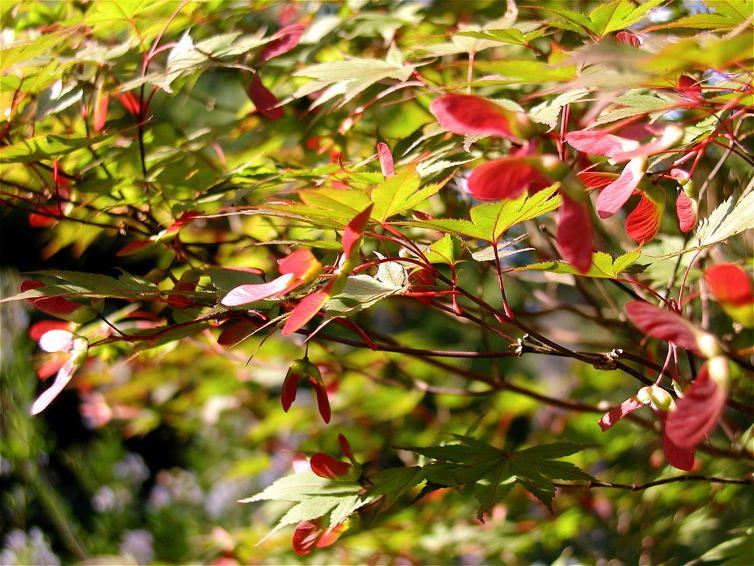
Japanese maple have been cultivated in Japan for centuries, and there are hundreds of named cultivars. In Japan these trees are called "Momiji", which means changing colors. Colors range from chartreuse to gold to dark green, from red to purple, to variegated white, green, and pink. The brighter reds and purples may soften to softer rose or green shades in summer. Bright red, burgandy, orange, and gold tones appear for fall, and these color variations can be spectacular. Sometimes I think I have too many of the red ones, for in the spring my garden is saturated with color. It's almost too much, and I am glad when the more subdued tones of summer arrive.
The seedlings may be quite different from the parents. A number of the Japanese maples in my yard were unnamed seedlings, and some of them are as beautiful as any named variety I have seen. 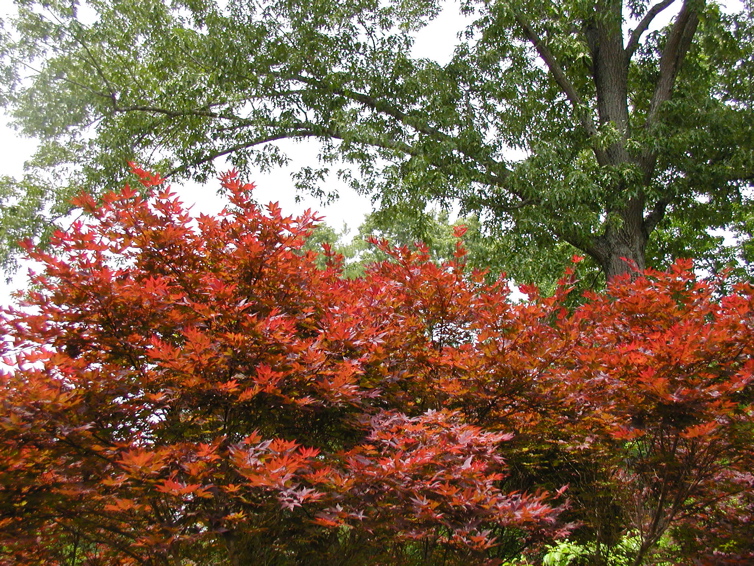 This brilliant foliage is from an unnamed Japanese maple. It was a small seedling when I planted it.My own trees are now producing babies, which I give away as gifts. I tell people to keep them in pots for a few years, until they are large enough to go into the garden.
This brilliant foliage is from an unnamed Japanese maple. It was a small seedling when I planted it.My own trees are now producing babies, which I give away as gifts. I tell people to keep them in pots for a few years, until they are large enough to go into the garden.
Grown in zones 5 to 8, cultivars vary from shrubs about eighteen inches tall to trees growing to twenty-five tall and wide. Their crowns may be rounded, weeping, or vase-shaped. They have a slow to moderate growth rate and like well drained, rich soil. They need to be well watered in their early years, but soggy soil can kill one of these tree. They should be pruned in fall after the leaves have fallen.
Their natural habitat is in the understory of woodlands.The red leafed varieties can usually take more sun, while the variegated ones need the protective cover of larger trees. Excess sun, wind or drought will cause leaf scorch. Most of my red Japanese maples are planted in full sun, but they were seedlings locally grown, so I think they have adapted well to our hot summer sun. Many of my Japanese maples had crispy leaves during our extended drought a couple years ago. Last year the rains returned, and there was no problem. A variegated Japanese maple "Butterfly" was about four feet tall when I planted it. It received hot sun for several hours a day, and despite my best efforts, it did not survive the drought. It was a gorgeous tree, and I think I will plant another one, but in a much shadier spot this time.
Some other Japanese maples I have in my garden: Another unnamed variety has fantastic gold fall foliage.
Another unnamed variety has fantastic gold fall foliage. 'Orido Nishiki' in the fall
'Orido Nishiki' in the fall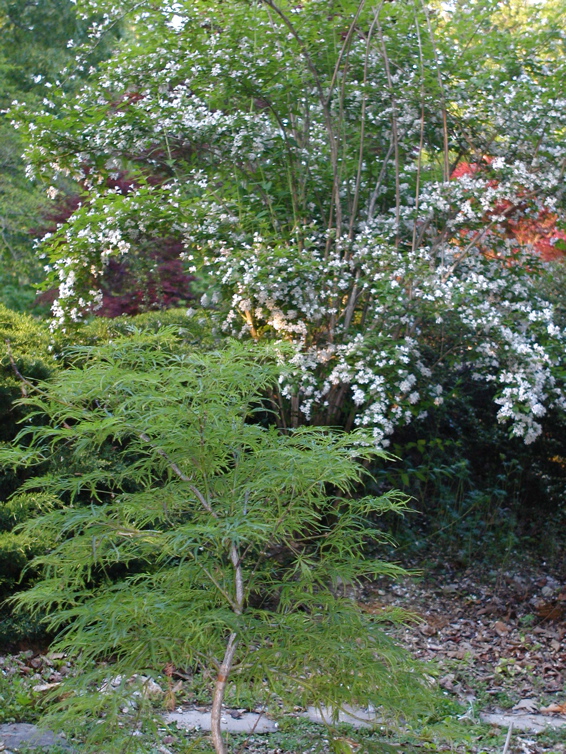 'Waterfall'
'Waterfall'
 Sold to me as 'Nishiki Gawa', but not what it is! It is a weeping tree with fine green leaves, tinged with pink in spring.
Sold to me as 'Nishiki Gawa', but not what it is! It is a weeping tree with fine green leaves, tinged with pink in spring. This shows the great structure of our 'marriage tree'.
This shows the great structure of our 'marriage tree'. Another unnamed seedling, grown into a beautyThese great trees have year-round appeal, and the larger ones probably deserve their hefty price tags. As you can see, however, even the unnamed seedling can grow into a fabulous specimen. While it has taken my seedlings twenty years to reach their present size, they were beautiful even when small. I have never done it, but Japanese maples are excellent specimens for bonsai, and many varieties do well in pots.
Another unnamed seedling, grown into a beautyThese great trees have year-round appeal, and the larger ones probably deserve their hefty price tags. As you can see, however, even the unnamed seedling can grow into a fabulous specimen. While it has taken my seedlings twenty years to reach their present size, they were beautiful even when small. I have never done it, but Japanese maples are excellent specimens for bonsai, and many varieties do well in pots.
So, if you have the right climate, there's bound to be a Japanese maple for you!
 Sunday, May 16, 2010 at 12:00PM
Sunday, May 16, 2010 at 12:00PM 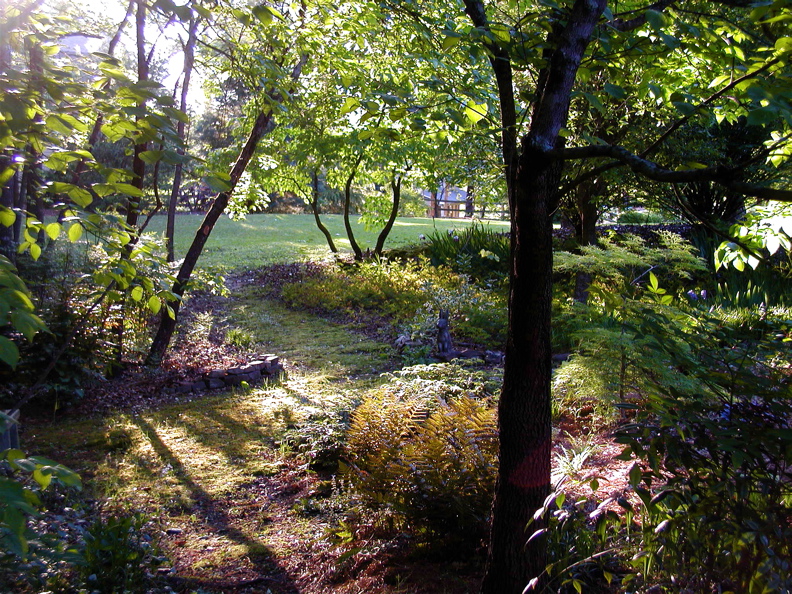 Golden light streams through the entrance to the woodland garden.
Golden light streams through the entrance to the woodland garden. Irises are beginning to blossom near the woodland entrance.
Irises are beginning to blossom near the woodland entrance.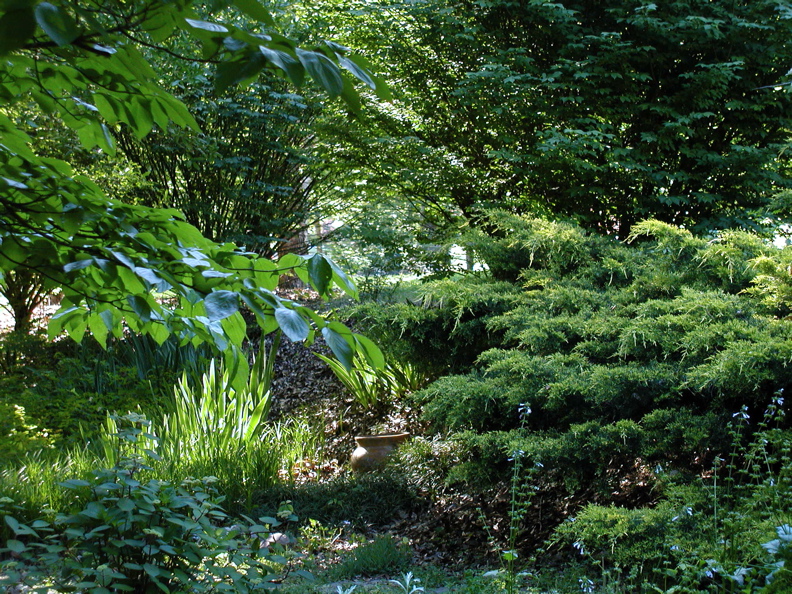 A tapestry of greens in the woodland garden
A tapestry of greens in the woodland gardenTop: Native redbud tree dripping with seed pods. Above, clockwise from upper left: Hydrangea 'Lady in Red', beginning to bud out; Variegated hydrangea; Native mahonia; Spreading Japanese plum yew
 Hosta 'sieboldiana elegans' glows in the light.
Hosta 'sieboldiana elegans' glows in the light. Sunlight and shadows create a serene atmosphere in the woodland garden.
Sunlight and shadows create a serene atmosphere in the woodland garden. the hillside in the woodland garden
the hillside in the woodland garden Ethereal light shines over the japanese maple I call our marriage tree.
Ethereal light shines over the japanese maple I call our marriage tree.'Endless Sumer' hydrangea buds announce the coming season.
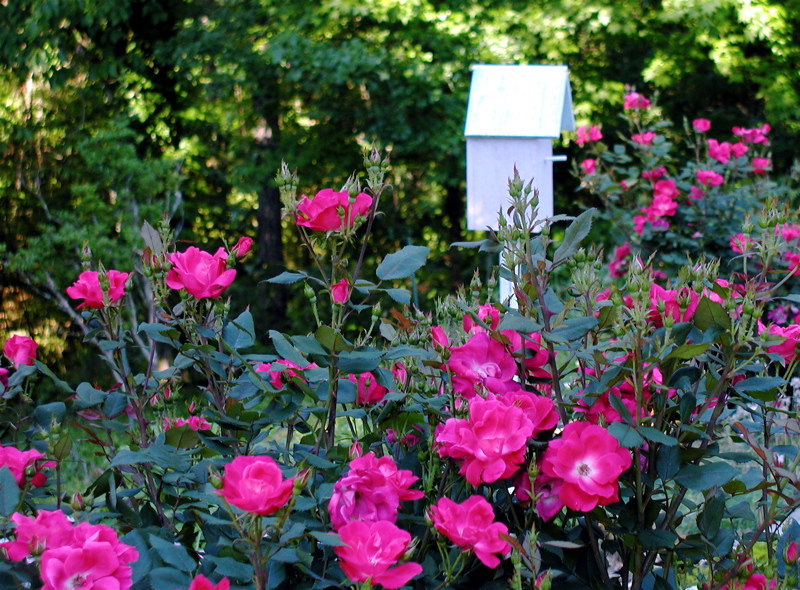 Knockout roses in the herb bed
Knockout roses in the herb bed1st row: Anthony Waterer spirea; Beauty Bush, Kolkwitzia amabilis. 2nd row: Southern arrowwood, Viburnum dentatum; French hollyhock, Malva sylvestris. 3rd row: Swamp rose, rosa palustris; very old azaleas. 4th row: Confederate or star jasmine; Blue salvia.





